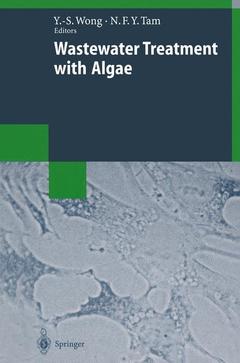Description
Wastewater Treatment with Algae, 1998
Biotechnology Intelligence Unit Series
Language: English
Subjects for Wastewater Treatment with Algae:
Publication date: 01-2013
234 p. · 15.5x23.5 cm · Paperback
234 p. · 15.5x23.5 cm · Paperback
Description
/li>Contents
/li>Comment
/li>
This book brings together environmental scientists and engineers to discuss the development of new approaches and methodologies which utilize microalgae for biological wastewater treatment. The researchers report their recent findings on microalgal removal of nutrients, heavy metals and other organic pollutants from sewage and industrial effluents. The technologies discussed here include biosorption and bioaccumulation of heavy metals, cell immobilization of algae, and mathematical modelling of metal uptake by cells. This book is unique in that it takes a practical approach to the subject matter and is a useful reference both in and outside of the laboratory.
1. Immobilized Algal Technology for Wastewater Treatment Purposes.- 2. Removal of Copper by Free and Immobilized Microalga, Chlorella vulgaris.- 3. Biosorption of Heavy Metals by Microalgae in Batch and Continuous Systems.- 4. Microalgal Removal of Organic and Inorganic Metal Species from Aqueous Solution.- 5. Bioaccumulation and Biotransformation of Arsenic, Antimony, and Bismuth Compounds by Freshwater Algae.- 6. Metal Ion Binding by Biomass Derived from Nonliving Algae, Lichens, Water Hyacinth Root and Sphagnum Moss.- 7. Metal Resistance and Accumulation in Cyanobacteria.- 8. Modelling the Uptake of Metal Ions by Living Algal Cells.- 9. Carrageenan as a Matrix for Immobilizing Microalgal Cells for Wastewater Nutrients Removal.- 10. Dynamics of Picoplankton and Microplankton Flora in the Experimental Wastewater Stabilization Ponds in the Arid Region of Marrakech, Morocco and Cyanobacteria Effect on Escherichia coli and Vibrio cholerae Survival.- 11. A Material Transformation Model For Biological Stabilization Ponds.- 12. Limits to Growth.
First practice-oriented title describing technologies for cleaning wastewater using algae or algal cells
© 2024 LAVOISIER S.A.S.




